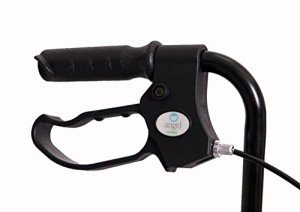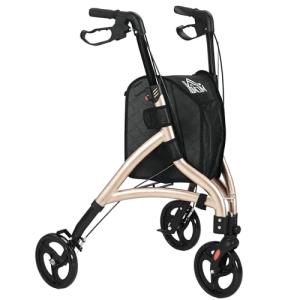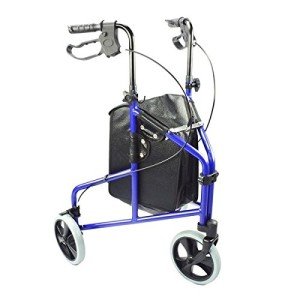Mobility aids have evolved significantly over the years, providing greater independence and convenience for those with limited mobility. Among these aids, the ultra lightweight 3-wheel rollator with a bag stands out as an excellent solution for individuals seeking stability, ease of movement, and practicality. This guide explores the characteristics, advantages, and key considerations that come into play when selecting an ultra lightweight 3-wheel rollator.
What is a 3-Wheel Rollator?
A rollator is a mobility aid designed to support individuals who have difficulty walking or maintaining balance. Unlike traditional walkers, rollators have wheels, allowing users to glide smoothly rather than lift the device off the ground. The 3-wheel rollator, as its name suggests, features three wheels that provide a lightweight, easy-to-maneuver option.
Key features of a 3-wheel rollator include:
- Three Wheels: This design allows for enhanced maneuverability in tight spaces, making it ideal for indoor use.
- Lightweight Frame: Composed of materials such as aluminum or high-grade plastic, these rollators weigh considerably less than their four-wheel counterparts.
- Built-in Bag or Basket: Many models come equipped with a bag or basket for carrying personal items, offering convenience for daily tasks.
- Adjustable Handlebars: Ergonomic handle adjustments ensure a comfortable fit for users of varying heights.
- Brakes: Most rollators feature easy-to-use brakes that provide stability and security during use.
Advantages of an Ultra Lightweight 3-Wheel Rollator
-
Portability: The ultra lightweight nature of these rollators makes them easy to transport. They can be folded down for convenient storage in cars, public transport, or at home.
-
Enhanced Mobility: The three-wheel design is particularly beneficial for navigating tight spaces, such as hallways, grocery store aisles, or crowded areas. Users can make sharp turns without hesitation, providing greater freedom of movement.
-
User-Friendly Design: The adjustable handlebars and lightweight construction make these rollators accessible to a broader range of users, including seniors and those recovering from injuries.
-
Storage Options: The built-in bag allows users to carry personal belongings, groceries, or other essentials without needing a separate tote or backpack.
-
Stability and Safety: Equipped with reliable braking systems and a stable base, these rollators provide a safe solution for those who need assistance with balance.
Considerations When Choosing a 3-Wheel Rollator
When selecting an ultra lightweight 3-wheel rollator, there are several factors to keep in mind to ensure the best fit for your needs:
1. Weight Capacity
- Evaluate the weight capacity of different models to ensure that the rollator can accommodate the user's needs. Most standard models support between 250 to 300 pounds.
2. Height Adjustability
- Opt for a rollator with adjustable handlebars for optimal ergonomics. A proper height adjustment is crucial for comfort and to maintain good posture.
3. Brake Mechanism
- Check the braking system for ease of use. Ensure that the brakes are reliable, responsive, and easy to operate, especially for users with limited hand strength.
4. Wheels
- Look at wheel size and material. Larger wheels may provide better stability, while smaller wheels offer enhanced maneuverability. Rubber wheels tend to provide a smoother ride.
5. Accessories
- Consider additional accessories, such as trays, cup holders, or backrests, that may enhance the functionality of the rollator.
6. Price and Warranty
- Evaluate your budget while considering the warranty options. A reliable warranty reflects the manufacturer’s confidence in their product.
FAQs
Q1: What is the difference between a 3-wheel and a 4-wheel rollator?
A1: The primary difference lies in the number of wheels and maneuverability. Three-wheel rollators are generally lighter and easier to navigate in tight spaces, while four-wheel models offer more stability and often come with a seat for resting.
Q2: Is a 3-wheel rollator suitable for outdoor use?
A2: Yes, many 3-wheel rollators are designed for both indoor and outdoor use. However, it is essential to check the wheel material and size to ensure they are suited for uneven terrain or sidewalks.
Q3: Can I use a 3-wheel rollator to carry heavy items?
A3: While the built-in bag or basket is convenient for carrying belongings, users should adhere to the weight capacity of the rollator to maintain safety. It is not advisable to overload it with heavy items.
Q4: How do I maintain my rollator to ensure its longevity?
A4: Regularly check the wheels, brakes, and frame for wear and tear. Clean the frame with mild soap and water, and lubricate the wheels as needed. Store the rollator in a dry place to prevent rust or deterioration.
Q5: Are there any additional accessories I can purchase for my rollator?
A5: Yes, many manufacturers offer accessories like trays, cup holders, night lights, storage pouches, and even seat cushions for added comfort.
The ultra lightweight 3-wheel rollator with a bag is more than just a mobility aid—it is a valuable companion that enhances independence and confidence for those with mobility challenges. By understanding the essential features, advantages, and factors to consider when selecting a rollator, users can choose the right product that addresses their unique needs. As mobility aids continue to evolve, the 3-wheel rollator stands as a testament to the importance of accessibility in everyday life.







